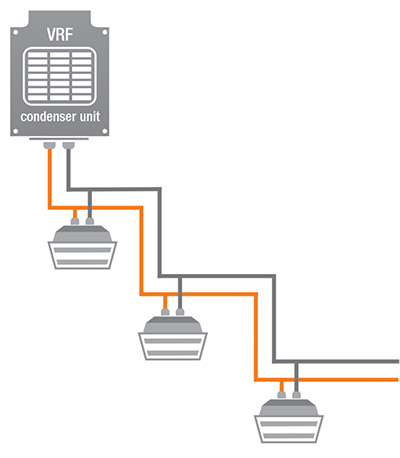What Is the Need for New Refrigerants?
Environmental considerations, especially the need to lower greenhouse gas emissions, are driving the switch to new refrigerants. When conventional refrigerants like R-410A are discharged into the environment, their high GWPs greatly contribute to climate change. The goal of regional directives like the European Union’s F-Gas Regulation and regulations like the Kigali Amendment to the Montreal Protocol is to gradually phase out high-GWP refrigerants and replace them with more environmentally friendly ones.
The low-GWP refrigerants R-32, R-454B, and R-290 are frequently used. Although these refrigerants have less of an impact on the environment, they do have special qualities that influence system performance, safety, and design.
VRF System Design Difficulties:
The design and functionality of VRF systems are greatly impacted by the switch to new refrigerants. Important difficulties include:
1. Safety and Flammability Issues:
According to ASHRAE standards, a large number of low-GWP refrigerants are categorized as either extremely flammable (A3) or mildly flammable (A2L). For instance:
- Since R-32 has an A2L rating, extra safety precautions must be taken while designing the system, including leak detection, adequate ventilation, and fire suppression systems in sensitive areas.
- Due to its high flammability and A3 rating, R-290 (propane) requires strict safety precautions and small charge sizes.
The advantages of reduced GWP must be weighed against the requirement to reduce flammability hazards, which can make system installation more difficult and expensive.
2. Properties Of The Refrigerant:
The thermodynamic characteristics of new refrigerants frequently differ from those of conventional refrigerants. For example:
- Efficiency of heat transmission: R-32 has greater heat transfer coefficients, which could increase system efficiency but needs modifying the design of the heat exchanger.
- Operating pressures: Certain refrigerants require modifications to compressor, valve, and pipe designs because they run at greater or lower pressures.
Engineers have to adjust system architectures and recalibrate components to account for these modifications.
3. Compatibility with Current Infrastructure:
Many modern refrigerants are not directly interchangeable, which adds another layer of difficulty to retrofit projects. It could be necessary to make significant changes to current systems to use them, such as replacing compressors, seals, and other parts to guarantee compatibility.
4. Effect on Installation and Manufacturing:
The design, production, and installation procedures of VRF systems are all impacted by the use of new refrigerants.
- Selection of Materials: The new refrigerants’ chemical characteristics must be compatible with the system’s components. Particularly for more reactive refrigerants, materials that are resistant to corrosion or breakdown are crucial.
- Certification and Training: To safely handle flammable refrigerants, installers and service technicians need specific training. This entails being aware of the correct procedures for handling, storage, and transportation in addition to being able to operate devices with sophisticated safety features.
- Cost Implications: The total cost of VRF systems rises due to the requirement for improved materials, safety measures, and training. To produce conforming products, manufacturers must invest in research and development, and consumers are likely to bear the burden of these expenditures.
5. Industry and Regulatory Standards:
The way that new refrigerants are adopted is greatly influenced by regulations. Safety regulations for systems using flammable refrigerants are outlined in standards like UL 60335-2-40 in the United States and EN 378 in Europe. The design of VRF systems is made more complex by the requirement to adhere to these standards.
Regional differences in regulatory requirements must also be taken into account by manufacturers and designers since these could affect the choice of refrigerant and system layout.
6. Innovation Possibilities:
Although there are many obstacles to overcome, switching to new refrigerants also offers chances for creative VRF system design. Among the possible directions for progress are:
- Improved Productivity: R-32 and other low-GWP refrigerants are more energy-efficient than conventional ones. Significant energy savings can be achieved by optimizing system design to take advantage of these characteristics.
- More Complex Monitoring and Controls: Safety and economy can be increased with smart control systems that track refrigerant levels, identify leaks, and adjust performance in real-time. These innovations are especially useful for systems that use flammable refrigerants.
- Scalable and Modular Designs: Modular VRF systems with reduced refrigerant charge sizes may be developed by manufacturers to address safety concerns. In addition to improving safety, this method gives system installation more flexibility.
Final Thoughts:
Although switching to low-GWP refrigerants is essential for environmental sustainability, there are several ways in which this hampers the design of VRF systems. Traditional methods need to be rethought in light of compatibility problems, flammability threats, and changes in refrigerant properties. Despite these difficulties, the change drives innovation and presents chances to improve system performance, safety, and efficiency. The HVAC sector can help create a more sustainable future by accepting these changes and making investments in technology and education.
Frequently Asked Questions:
1. What Is AC Steam Cleaning?
High-temperature steam is used in the steam washing process to clean AC parts like vents, coils, and filters. It efficiently eliminates dust, debris, bacteria, and mould, improving cooling efficiency and air quality. This eco-friendly and chemical-free method is a great way to keep your air conditioner in good working order.
2. Why Is It Necessary To Steam Clean Air Conditioners?
Steam cleaning guarantees complete cleaning, eliminating mould, germs, and allergens that might build up in the air conditioner over time. It increases indoor air quality, lowers energy usage, and boosts your unit’s efficiency. Regular steam cleaning prevents blockages and corrosion in air conditioner components, extending its lifespan.


